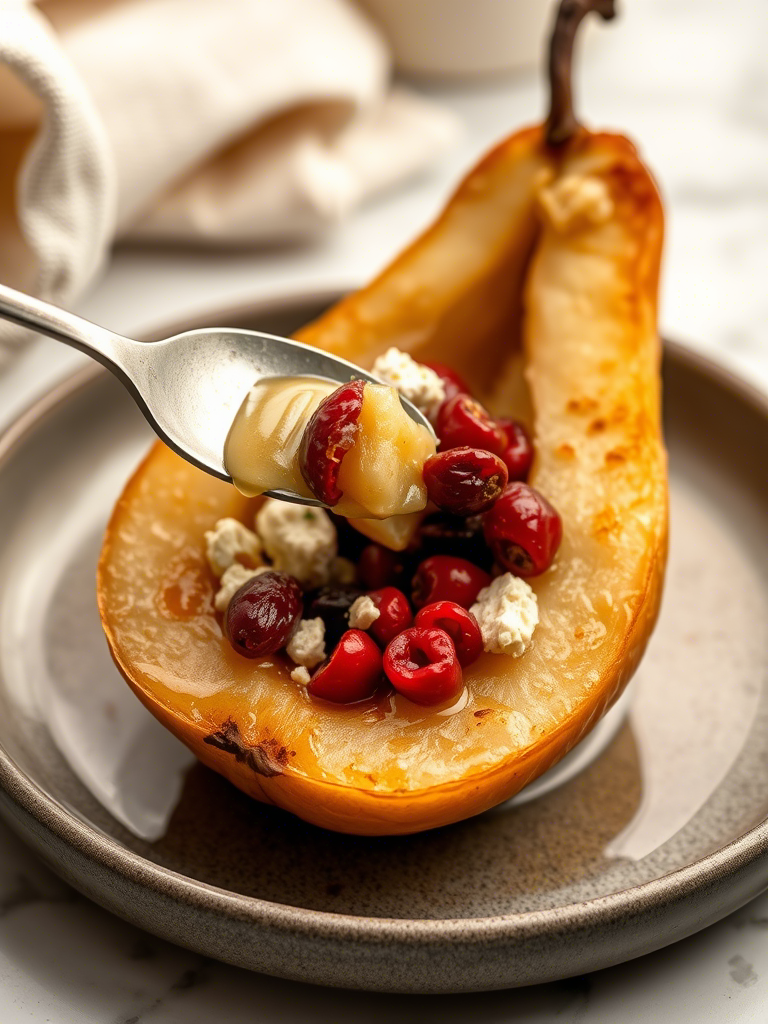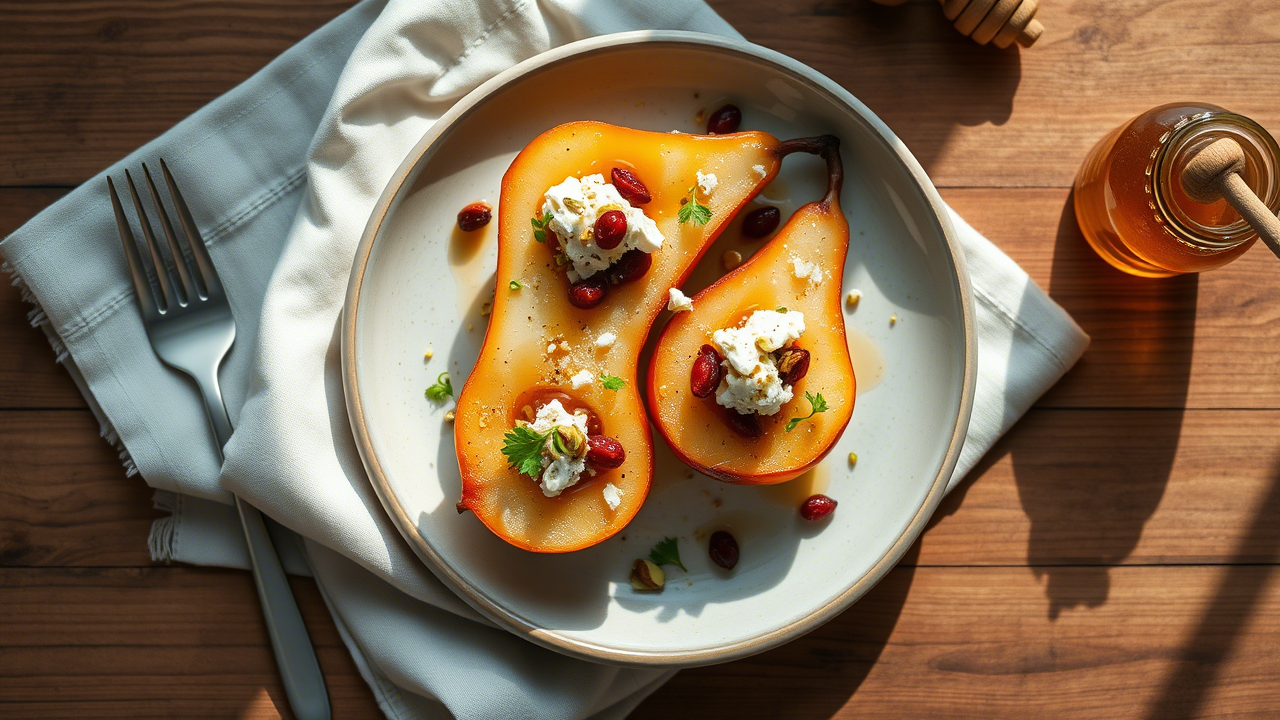There’s something quietly profound about pears. They don’t shout like citrus or beg for attention like berries. They wait. Patient. Understated. But when they hit that peak of ripeness—soft, floral, dripping with subtle perfume—they become magic. That’s exactly why Baked Pears with Feta, Honey, and Cranberries is a dish worth talking about. Not just for its flavor, which is obvious. But for its unexpected sophistication, its simplicity, and frankly, its versatility in a professional kitchen.
This isn’t just a dessert. It’s not just an appetizer. It’s not even really just a dish. It’s a gesture. Of balance, of restraint, of understanding what flavor wants to become when heat nudges it forward. If you work in food, you get it: the quiet dishes are the ones that leave people whispering at the table.
This dish? It does that.
Why Baked Pears?
Pears, when baked, undergo what you might call a soft transformation. They’re not caramelized in the aggressive way apples can be. They don’t melt down like stone fruits. Instead, they mellow. The natural sugars deepen, the structure relaxes just enough. They become custard-like without being cloying. The result is subtle and gentle but grounded. It’s a warm, earthy sweetness.
Now layer that with sharp feta—crumbly, salty, tangy. Toss in dried cranberries, with their chewy texture and wine-like tartness. Drizzle over raw honey. Real honey. Preferably local. Preferably wild. You’ve just crossed from simple to sublime.
Ingredient Selection: The Devil’s in the Details
Let’s break down the core players. Each one’s doing heavy lifting here.
Pears: The Canvas
Go for Bosc or Anjou. Bosc, especially, has a firmer texture and holds up beautifully in the oven. Bartletts? They’re lovely raw but collapse too easily under heat. What you want is structure with sweetness.
Peel? Leave it on. It adds a bit of chew and protects the flesh. Plus, the skin on Bosc pears turns bronze and beautifully rustic after baking. Core them, yes, but don’t butcher them. Use a melon baller or a Parisienne scoop. Make a neat, defined well—you’re not digging a grave here.
Oh, and don’t use overripe pears. If they smell like perfume and feel like mush, they’ve missed the bus.
Feta: The Funk Factor
This is not the time for cheap supermarket feta. You want sheep’s milk, or at the very least, a blend with goat. Block form, stored in brine. Not those dry crumbles in plastic tubs. Real feta will bring an umami bomb with grassy depth, almost a chalky punch that cuts clean through the sweetness of the pear.
Want to go rogue? Try Bulgarian feta. Saltier, creamier, and slightly more intense. But use less—it’s potent.
Honey: Liquid Gold
If you’re using clover honey from a squeeze bottle, just stop. Use wildflower, acacia, or chestnut. Something with backbone. Something with nuance. Acacia’s light and floral. Chestnut’s bitter and dark—almost molasses-like. A drizzle is all you need.
For the love of everything holy in a pantry, do not bake the honey. Add it after. Let it sit atop the warm pear like sunlight on late autumn skin. Honey changes character under heat—it loses its raw edge, its floral notes. Don’t rob it of that.
Cranberries: The Acid Hit
You need dried cranberries, yes. But look for unsweetened or lightly sweetened varieties. The ones packed with added sugar taste like candy and dull the tartness you need to balance the dish.
Steep them briefly in hot water or warm white wine before use. Just a few mins. Plumps them up, wakes up their natural oils, gives you something with chew, not cardboard.

Baking Process: Precision Over Guesswork
This dish isn’t difficult—but it is precise. Sloppy execution shows.
Prep: Preheat your oven to 375°F (190°C). Use a baking dish that holds the pears snugly so they don’t tip over. Drizzle with a little olive oil—not butter. Butter adds richness, yes, but the olive oil complements the savory notes better.
Bake: 25 to 30 minutes. That’s it. Don’t go for that slow, hour-long roast. You want the pear warmed through, slightly softened, but still able to hold form. Tent with foil if they begin to brown too quickly.
Finishing Touches: Immediately upon pulling them from the oven, crumble the feta into the warm hollows. Let it soften slightly but not melt. Then come the cranberries. Then the honey. Maybe a crack of black pepper. Maybe a leaf of thyme.
Expert Tip: Add Texture
You know what takes this from good to ridiculous? Crunch.
A few toasted walnuts or pecans scattered over the top add the kind of texture your palate dreams about at night. Not too many. Just enough to contrast the softness.
If you’re plating this as an appetizer or side, add a swipe of labneh or Greek yogurt on the plate. Cold against warm, tart against sweet—it’s a chef’s kiss in dairy form.
Flavor Pairings and Service Ideas
As a Starter
Serve one half pear per person on a bed of arugula. The peppery greens make a beautiful foil to the sweetness. Add a drizzle of balsamic reduction if you’re feeling extra. This has worked well in seasonal menus—especially in early fall.
As a Dessert
Yes, dessert. Drop the arugula. Serve with a scoop of mascarpone or crème fraîche on the side. Finish with crushed pink peppercorns for that unexpected floral bite. People will remember this. Trust me.
On a Cheese Board
Slice into wedges and fan out alongside a wheel of triple crème, a wedge of aged Manchego, and some candied nuts. It’s not traditional. It’s better.
Nutrition, Balance, and Menu Engineering
This dish walks a line between indulgence and restraint. Per half pear, you’re looking at:
- ~120–160 calories
- 2g protein (feta)
- 6–8g natural sugars
- 5g fat (mostly from the cheese)
That’s a light starter by most standards. If you’re doing seasonal tasting menus, it fits neatly without throwing off the calorie balance. For vegan adaptations? Swap feta for whipped almond “ricotta” and the honey for maple or date syrup. It works. Not exactly the same, but it works.
It also aligns with current trends: clean eating, fruit-forward dishes, Mediterranean-style flavor layering. Every part of this dish hits a note that diners are craving right now—sweet-savory contrast, minimal processing, and full ingredient transparency.
Common Mistakes (Don’t Make ‘Em)
- Using overripe pears. They collapse and taste mushy. Unpleasant.
- Overbaking. Pears aren’t pie filling. Keep their dignity intact.
- Adding the feta before baking. It dries out, browns, and tastes chalky.
- Skimping on the honey. But also, don’t drown it. Balance is everything.
- Using low-quality cheese. It throws the whole dish off.
Real-World Applications
I’ve seen this dish used in boutique cafés in Brooklyn, wedding catering in Sonoma, and even fine dining tasting menus in Copenhagen. It adapts. It charms. It’s that rare dish that can wear multiple hats.
One high-end spot in Portland serves it with pickled mustard seeds. Another layers it into phyllo cups for passed hors d’oeuvres. I’ve even used it in culinary classes to teach flavor contrast. Students love it because it’s simple, but when they taste it, they’re shook.

Key Takeaways for Chefs
- Highlight contrast. This dish lives or dies by contrast—sweet, savory, soft, crisp, warm, cool.
- Elevate ingredients. Don’t go cheap. The dish is too simple to hide low-quality parts.
- Respect timing. The bake is short. The finishing touches matter more than the oven.
- Think seasonally. Best from late summer through winter. But adaptable, always.
Final Thoughts: A Dish That Speaks Softly but Stays Loud
If you’re tired of over-the-top creations and want something that speaks in quiet, poetic flavors, Baked Pears with Feta, Honey, and Cranberries might be what you’re looking for. It doesn’t scream for attention, but it lingers. It haunts. It’s the kind of dish people don’t forget—and that’s worth something.
Professionally, it’s flexible. Personally, it’s comforting. And culinarily? It’s a masterclass in restraint.
Serve it warm. Serve it proud. And for the love of salt, don’t skip the feta.
FAQs
What type of pears are best for baking in this recipe?
Bosc or Anjou pears work best because they hold their shape and have a firm texture.
Can I use pre-crumbled feta?
No, block feta in brine has better flavor and texture—avoid the dry crumbles.
Should I peel the pears before baking?
Nope, leave the skin on—it adds texture and helps the pears hold together.
When should I add the honey?
Always after baking, so it keeps its raw floral flavor and doesn’t lose complexity.
Can I make this dish vegan?
Yes, use almond ricotta instead of feta and maple syrup instead of honey.
How long do the pears need to bake?
About 25 to 30 minutes at 375°F, just until tender but not mushy.
Do I need to soak the cranberries first?
Yes, soak them briefly in hot water or wine to plump and improve texture.
Can this be served as a dessert?
Absolutely—just pair with mascarpone or crème fraîche for a sweet finish.
What can I add for crunch?
Toasted walnuts or pecans work great for texture contrast.
Is this recipe suitable for menus with dietary restrictions?
Yes, it’s gluten-free and easily adaptable to vegetarian and vegan diets.
What’s the calorie count per serving?
Roughly 120–160 calories per half pear, depending on toppings used.
Can I prepare this ahead of time?
Partially—bake the pears ahead, then reheat and add toppings just before serving.
What kind of honey is best?
Raw wildflower or acacia honey gives the best depth and character.

Mariana is a passionate home cook who creates delicious, easy-to-follow recipes for busy people. From energizing breakfasts to satisfying dinners and indulgent desserts, her dishes are designed to fuel both your body and hustle.
When she’s not in the kitchen, she’s exploring new flavors and dreaming up her next recipe to share with the Foodie Hustle community.

